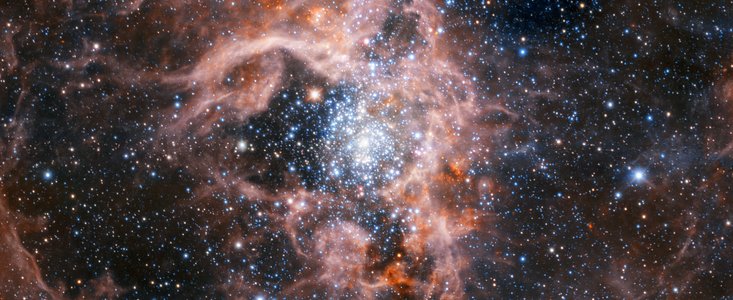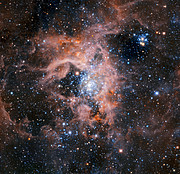Announcement
Sharper Images for VLT Infrared Camera
Adaptive optics facility extended to HAWK-I instrument
30 January 2018
ESO’s Very Large Telescope (VLT) now has a second instrument working with the powerful Adaptive Optics Facility (AOF). The infrared instrument HAWK-I (High Acuity Wide-field K-band Imager) [1] is now also benefiting from sharper images and shorter exposure times. This follows the successful integration of the AOF with MUSE (the Multi Unit Spectroscopic Explorer).
The Adaptive Optics Facility (AOF) is a long-term project that is nearing completion on ESO’s Very Large Telescope (VLT). It provides adaptive optics correction for all the instruments attached to one of the VLT Unit Telescopes (UT4, also known as Yepun).
Adaptive optics works to compensate for the blurring effect of the Earth’s atmosphere. This upgrade now enables HAWK-I to obtain sharper images, needing shorter exposure times than before to obtain similar results. By using the AOF, astronomers can now get good image quality with HAWK-I, even when the weather conditions are not perfect.
Following a series of tests of the new system, the commissioning team of astronomers and engineers were rewarded with a series of spectacular images, including one of the Tarantula Nebula star-forming region in the Large Magellanic Cloud.
The AOF, which made these observations possible, is composed of many parts working together. These include the Four Laser Guide Star Facility (4LGSF) and the UT4’s very thin deformable secondary mirror, which is able to change its shape [2] [3]. The 4LGSF shines four 22-watt laser beams into the sky to make sodium atoms in the upper atmosphere glow as bright points of light, forming artificial guide stars.
Sensors in the adaptive optics module GRAAL (GRound layer Adaptive optics Assisted by Lasers) use these artificial guide stars to determine the atmospheric conditions. One thousand times per second, the AOF system calculates the correction that must be applied to the telescope’s deformable secondary mirror to compensate for the atmospheric disturbance.
GRAAL corrects for the turbulence in the layer of atmosphere up to about 500 metres above the telescope — the “ground layer”. Depending on the conditions, atmospheric turbulence occurs at all altitudes, but studies have shown that the largest fraction of the disturbance occurs in the ground layer of the atmosphere.
The corrections applied by the AOF rapidly and continuously improve the image quality by concentrating the light to form sharper images, allowing HAWK-I to resolve finer details and detect fainter stars than previously possible.
MUSE and HAWK-I are not the only instruments that will benefit from the AOF; in future, the new instrument ERIS will be installed on the VLT. The AOF is also a pathfinder for adaptive optics on ESO’s Extremely Large Telescope (ELT).
Notes
[1] HAWK-I is a wide-field imager, an instrument that takes images of the sky in infrared wavelengths. This allows it to see inside interstellar dust and gas, which blocks optical light. The instrument uses four imaging chips simultaneously to achieve such a large field of view, capturing a wealth of information.
[2] At just over one metre in diameter, this is the largest adaptive optics mirror in operation and demanded cutting-edge technology to make it. It was mounted on UT4 in 2016 (ann16078) to replace the telescope’s original conventional secondary mirror.
[3] Other tools to optimise the operation of the AOF have been developed and are now operational. These include an extension of the Astronomical Site Monitor software that monitors the atmosphere to determine the altitude at which the turbulence is occurring, and the Laser Traffic Control System (LTCS) that prevents other telescopes looking into the laser beams or spots and potentially affecting their observations.
Links
- GRAAL and the VLT deformable secondary mirror technical information
- Event to mark the first light of the 4 Laser Guide Star Facility on the VLT
- The HAWK-I camera
Contacts
Harald Kuntschner
ESO, AOF Project Scientist
Garching bei München, Germany
Tel: +49 89 3200 6465
Email: hkuntsch@eso.org
Richard Hook
ESO Public Information Officer
Garching bei München, Germany
Tel: +49 89 3200 6655
Cell: +49 151 1537 3591
Email: rhook@eso.org
About the Announcement
| Id: | ann18006 |



